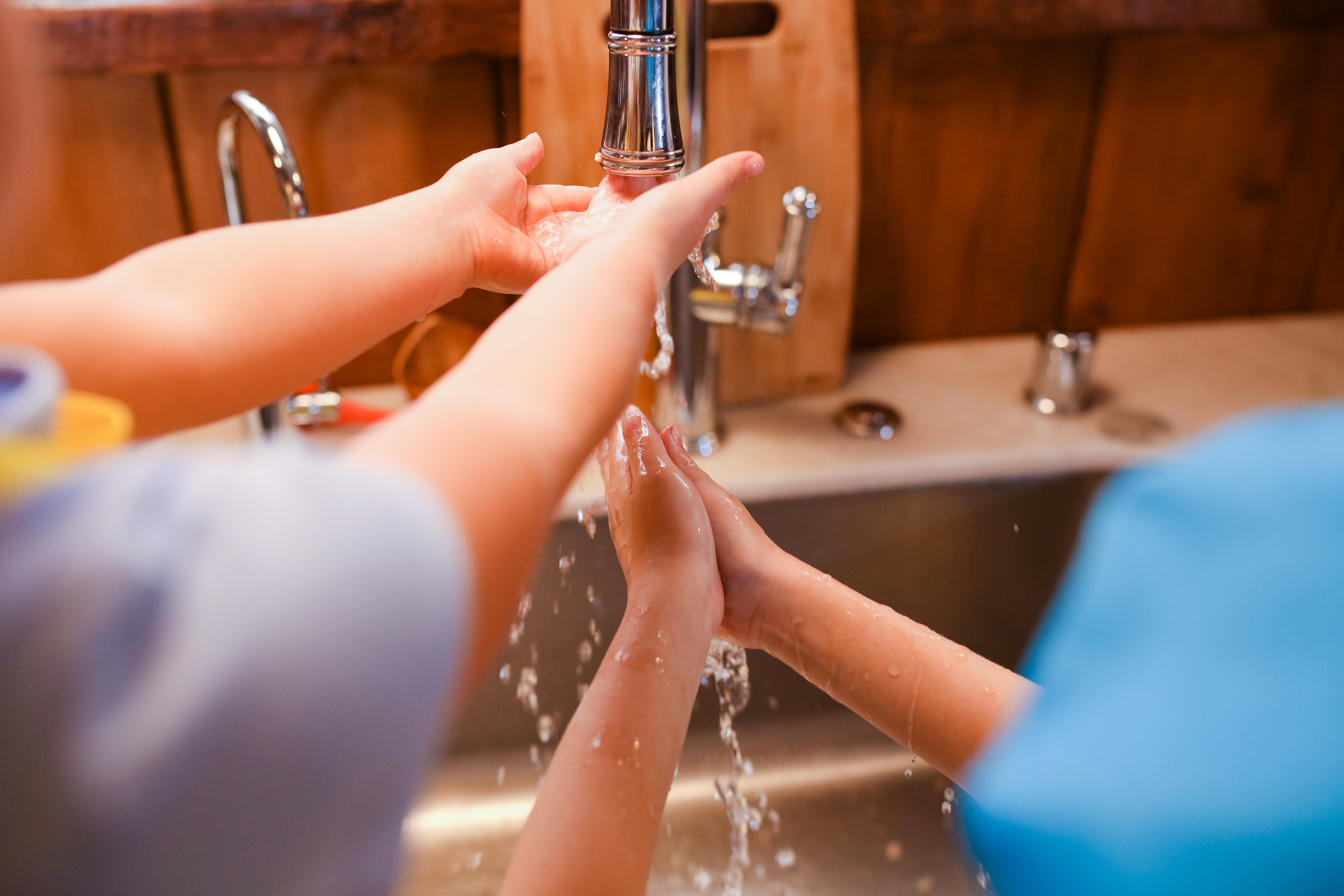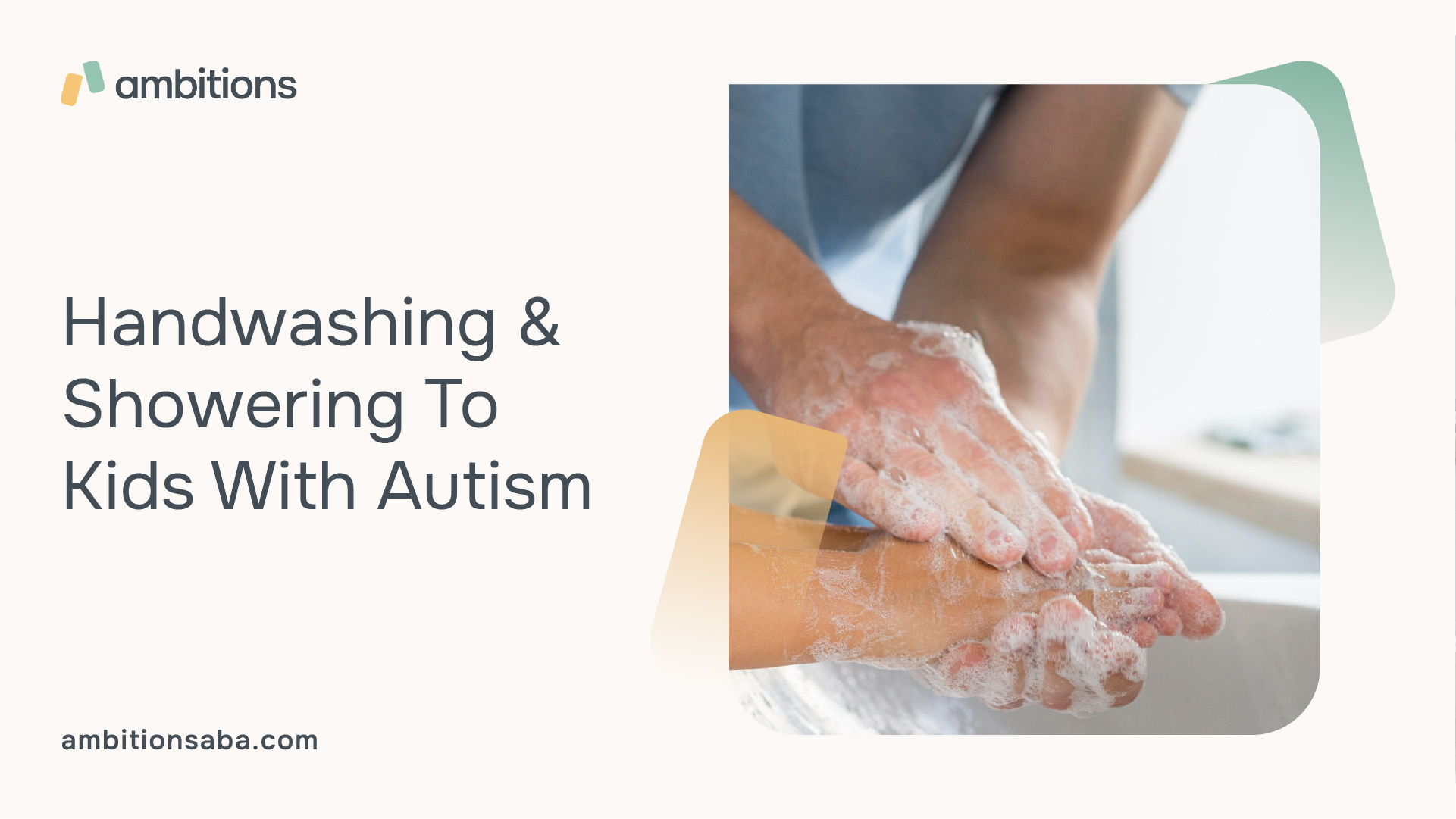"Discover how facial features may provide clues to autism diagnosis.
Handwashing & Showering To Kids With Autism
When it comes to children with autism, promoting hygiene skills can present unique challenges. It is important for parents and caregivers to understand these challenges in order to provide appropriate support and help their children develop essential hygiene habits. In this section, we will explore the relationship between autism and sensory processing, as well as common hygiene challenges faced by children with autism.

Autism and Sensory Processing
Autism is a neurodevelopmental disorder that affects individuals' social communication and behavior. Many children with autism also experience sensory processing differences, which can impact their response to various sensory stimuli, including those related to hygiene routines.
Sensory processing challenges can manifest in different ways. Some children may be hypersensitive, meaning they are overly sensitive to certain sensations. For example, they may find the feeling of water on their skin during handwashing or showering to be overwhelming or uncomfortable. On the other hand, some children may be hyposensitive, which means they have a reduced sensitivity to sensory input. These children may not feel the need for personal hygiene or may struggle to recognize when they are dirty.
Understanding a child's sensory profile is essential for tailoring hygiene strategies to their specific needs. By creating a sensory-friendly environment and using techniques that accommodate their sensory preferences, parents can help children with autism overcome these challenges and develop good hygiene habits.

Common Hygiene Challenges in Children with Autism
Children with autism may face specific hygiene challenges that require attention and support. Some common challenges include:
- Sensory aversions: Certain textures, smells, or sensations associated with hygiene routines, such as toothbrushing or hair washing, may trigger sensory aversions in children with autism. This can make it difficult for them to engage in these activities.
- Difficulty with transitions: Children with autism often thrive on routine and predictability. Transitioning from one activity to another, such as moving from playtime to bath time, can be challenging and may lead to resistance or meltdowns.
- Limited social imitation skills: Many children with autism struggle with imitation skills, which can make it challenging for them to observe and learn hygiene routines by watching others.
- Executive functioning difficulties: Executive functioning skills, such as planning, organizing, and sequencing tasks, may be impaired in children with autism. This can make it challenging for them to follow the steps involved in hygiene routines independently.
Understanding these common challenges allows parents to approach hygiene routines with empathy and patience. By implementing strategies tailored to their child's needs, parents can help their children overcome these challenges and develop essential hygiene skills.
Importance of Promoting Hygiene Skills
When it comes to children with autism, promoting hygiene skills is of utmost importance. Teaching and encouraging personal hygiene habits not only fosters independence but also has a significant impact on their social and emotional well-being.
Personal Hygiene and Independence
Promoting personal hygiene skills in children with autism plays a crucial role in fostering their independence. By teaching them how to take care of their own hygiene needs, we empower them to become more self-sufficient and confident in their abilities.
Developing skills such as handwashing, brushing teeth, and showering enables children with autism to take control of their personal care routines. This independence not only reduces their reliance on others but also enhances their sense of self-esteem and accomplishment.
Social and Emotional Well-being
Good personal hygiene practices have a direct impact on the social and emotional well-being of children with autism. When children maintain proper hygiene, they are more likely to feel comfortable in social situations and interact with others confidently.
Poor hygiene can lead to social isolation, teasing, and a negative impact on self-esteem. By promoting and reinforcing hygiene skills, we can help children with autism build positive relationships, participate in social activities, and improve their overall well-being.
Benefits of Promoting Hygiene Skills in Children with Autism
- Increased independence
- Enhanced self-esteem and confidence
- Improved social interactions
- Positive impact on overall well-being
Ensuring that children with autism develop and maintain good hygiene habits is essential for their personal growth and overall quality of life. By recognizing the importance of promoting hygiene skills, we can support their independence and contribute to their emotional and social well-being.
Strategies for Promoting Handwashing Skills
When it comes to promoting hygiene skills in children with autism, there are various strategies that can be implemented to facilitate the development of handwashing skills. Two effective strategies include the use of visual supports and schedules, as well as sensory-friendly products and techniques.
Visual Supports and Schedules
Children with autism often benefit from visual aids and structured routines. Visual supports, such as visual schedules and step-by-step visual guides, can help children understand and follow the handwashing process. These visual cues provide a clear and predictable sequence of steps, reducing anxiety and increasing independence.
Visual Supports and Schedules
- Visual schedules with pictures or icons depicting each step of handwashing
- Visual guides with simple, illustrated instructions for handwashing
- Social stories that describe the importance and procedure of handwashing
- Use of a timer or visual countdown to help children understand the duration of handwashing
By incorporating visual supports and schedules, parents can empower their children with autism to develop a consistent and effective handwashing routine.
Sensory-friendly Products and Techniques
Children with autism may have sensory sensitivities that can make the sensation of water and certain textures uncomfortable or overwhelming. To promote handwashing skills, it's essential to consider sensory-friendly products and techniques that can address these sensitivities.
Sensory-friendly Products and Techniques
- Use of warm water instead of cold water to provide a more pleasant sensory experience
- Offering a choice of soap with different scents or textures to accommodate sensory preferences
- Providing soft and non-abrasive towels or hand dryers to avoid discomfort
- Incorporating handwashing tools, such as foaming soap or a sensory-friendly handwashing station, to make the experience more engaging
By tailoring the handwashing experience to the specific sensory needs of children with autism, parents can help reduce sensory challenges and make handwashing a more enjoyable and successful task.
Remember, each child with autism is unique, and it may be necessary to experiment with different strategies to find what works best for your child. By incorporating visual supports and schedules, as well as sensory-friendly products and techniques, parents can play a vital role in promoting effective handwashing skills and overall hygiene in their children with autism.
Techniques for Promoting Showering Skills
For children with autism, learning and practicing showering skills can be challenging. However, with the right strategies and support, it is possible to help them develop these important hygiene skills. In this section, we will explore two techniques that can be effective in promoting showering skills: gradual exposure and desensitization, and the use of visual and social stories.
Gradual Exposure and Desensitization
Gradual exposure and desensitization involve introducing the showering process in small, manageable steps, gradually increasing the level of exposure and sensory input over time. This technique allows children with autism to become familiar with the sensations and routines associated with showering at their own pace.
To implement gradual exposure and desensitization:
- Start with familiarization: Begin by simply having the child observe or stand near the shower while it is running. Encourage them to become comfortable with the sight, sound, and feel of the water.
- Introduce touch: Once the child is comfortable, introduce them to the sensation of water by allowing them to touch it with their hands or feet. This can be done outside the shower or by using a small container of water.
- Step-by-step progression: Gradually progress to having the child stand under the shower for a brief period while wearing their clothes. Then, gradually transition to removing their clothes and experiencing a full shower, starting with shorter durations and gradually increasing the time.
Remember to be patient and understanding throughout this process. It may take time for the child to feel comfortable with each step, and it's important to respect their individual pace.
Visual and Social Stories
Visual and social stories are effective tools for teaching and preparing children with autism for new experiences, including showering. These stories use visual supports, such as pictures or drawings, along with simple and descriptive language to help the child understand the sequence of events, expectations, and any potential challenges they may encounter during the showering process.
To create visual and social stories for showering:
- Identify key steps: Break down the showering routine into simple steps, such as undressing, adjusting the water temperature, shampooing, rinsing, and drying off.
- Create visual supports: Use pictures or drawings to illustrate each step of the showering process. You can also include captions or short descriptions to provide additional clarity.
- Include personalized details: Tailor the visual and social stories to the child's specific needs and preferences. For example, include pictures of their own shower or bathroom to create familiarity and comfort.
- Read and review the stories: Read the visual and social stories with the child regularly to reinforce the routine and expectations. Encourage them to ask questions and provide reassurance.
By implementing gradual exposure and desensitization techniques and utilizing visual and social stories, parents can support their children with autism in developing showering skills. These strategies provide structure, predictability, and visual support, which can significantly reduce anxiety and increase their comfort level throughout the showering process.
Creating a Hygiene Routine
Establishing a consistent and structured hygiene routine is essential when promoting hygiene skills in children with autism. By providing a predictable framework, parents can help their children develop and maintain good hygiene habits. Two key components in creating a hygiene routine are establishing consistency and structure, as well as utilizing reinforcement and positive reinforcement strategies.
Establishing Consistency and Structure
Consistency is crucial for children with autism, as it helps create a sense of predictability and reduces anxiety. When establishing a hygiene routine, it's important to follow a consistent schedule. This means setting specific times for activities such as handwashing and showering and sticking to them as much as possible. Using visual supports, such as visual schedules or timers, can also help children understand and anticipate the sequence of hygiene tasks.
In addition to consistency, providing structure within the routine can help children with autism navigate the steps involved in maintaining hygiene. Breaking down tasks into smaller, manageable steps can make them less overwhelming. For example, for handwashing, you can create a visual chart or checklist that outlines each step involved: turning on the water, wetting hands, applying soap, lathering, rinsing, and drying. This visual guide can serve as a helpful reminder and guide for the child to follow.
Reinforcement and Positive Reinforcement Strategies
Reinforcement is an effective strategy to motivate and encourage children with autism to engage in proper hygiene practices. Positive reinforcement involves rewarding desired behaviors to increase the likelihood of their recurrence. When it comes to promoting hygiene skills, parents can implement various reinforcement strategies.
One approach is to provide verbal praise and encouragement. Acknowledging and praising the child's efforts, even for small achievements, can boost their confidence and motivation. For example, when a child successfully completes a hygiene task, such as washing their hands independently, parents can offer specific praise like, "Great job washing your hands! You did it all by yourself!"
Another reinforcement strategy is to use tangible rewards. These can be small incentives or privileges that the child finds motivating. For instance, creating a reward chart where the child earns a sticker or a token for each successful completion of a hygiene task. After accumulating a certain number of stickers or tokens, the child can be rewarded with a preferred activity or item.
It's important to tailor the reinforcement strategies to the individual preferences and needs of the child. What motivates one child may not be effective for another. By understanding the child's interests and using appropriate reinforcement strategies, parents can make the hygiene routine more engaging and enjoyable for their child with autism.
By establishing consistency and structure within a hygiene routine and incorporating reinforcement and positive reinforcement strategies, parents can effectively promote hygiene skills in children with autism. These approaches help create a supportive and encouraging environment that enables children to develop essential hygiene habits and maintain their personal well-being.
Seeking Professional Support
When it comes to promoting hygiene skills in children with autism, seeking professional support can be immensely beneficial. Occupational therapy and behavioral therapy, including Applied Behavior Analysis (ABA), are two approaches that can help children develop and improve their hygiene routines.
Occupational Therapy
Occupational therapy focuses on enhancing a child's ability to participate in everyday activities, including hygiene tasks. Occupational therapists work with children with autism to address sensory processing challenges, fine motor skills, and adaptive behaviors that may impact their ability to engage in proper hygiene practices.
By conducting thorough assessments, an occupational therapist can identify specific areas of difficulty and develop personalized interventions to target those challenges. These interventions may include:
- Sensory integration techniques to help children with sensory processing difficulties adapt to the sensations associated with hygiene tasks.
- Developing visual schedules and supports to provide step-by-step guidance and structure during hygiene routines.
- Encouraging the use of sensory-friendly products and techniques to make the experience more comfortable and enjoyable for the child.
Behavioral Therapy and Applied Behavior Analysis (ABA)
Behavioral therapy, particularly Applied Behavior Analysis (ABA), is another valuable approach for promoting hygiene skills in children with autism. ABA focuses on understanding and modifying behavior through systematic and evidence-based strategies. In the context of hygiene skills, ABA can help children develop appropriate behaviors and overcome challenges they may face.
ABA techniques that can be applied to promote hygiene skills include:
- Using visual and social stories to explain and demonstrate proper hygiene practices in a clear and understandable manner.
- Implementing gradual exposure and desensitization techniques to help children become more comfortable with showering and other hygiene tasks.
- Establishing consistent routines and providing reinforcement and positive reinforcement strategies to motivate and reward desired hygiene behaviors.
By incorporating occupational therapy and behavioral therapy into a child's comprehensive treatment plan, parents can effectively support their child's development of hygiene skills. These professional interventions, coupled with consistency and patience, can make a significant difference in helping children with autism overcome hygiene challenges and cultivate important self-care abilities.
FAQs
What kind of support is available for students with autism in college?
Many colleges and universities offer support services for students with disabilities, including those with autism. These may include academic accommodations such as extended time on exams or note-taking assistance, as well as social and emotional support such as counseling or peer mentoring programs.
How can I help my child prepare for the transition to college?
It's important to involve your child in the process of preparing for college as much as possible. Encourage them to research different schools and programs, visit campuses if possible, and make connections with disability support services at their chosen school. You can also work together on developing independent living skills such as budgeting, time management, and self-advocacy.
What are some common challenges that students with autism may face in college?
Some common challenges include difficulty with social interactions or communication, sensory overload in busy campus environments, and managing academic workload and deadlines. It's important to work with your student and their support team to develop strategies for addressing these challenges.
Are there any resources available specifically for parents of students with autism in college?
Yes! There are many online communities and organizations dedicated to supporting parents of children with autism through the transition to college. These can provide valuable information and resources on topics such as financial aid, legal rights, and navigating the college system.
Summary
Helping your child develop good hygiene habits can be a challenge, but it's an important part of their overall health and well-being. By understanding their unique needs and preferences, creating a consistent routine, and making the process fun and engaging, you can help your child feel more comfortable and confident with handwashing and showering. With patience, positivity, and a little creativity, you can set your child up for success and help them thrive.

